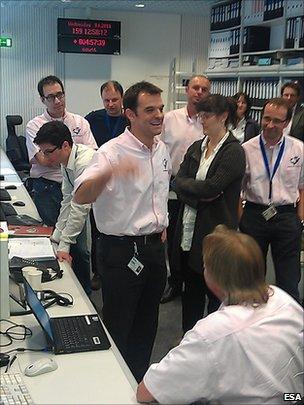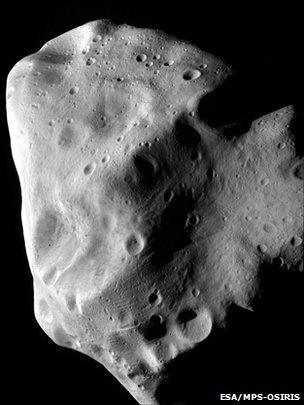Rosetta comet chaser goes into deep sleep
- Published

Rosetta is a long way from home, and it is now picking up very little energy from the Sun
Europe's Rosetta spacecraft, which is heading for a rendezvous with a comet in 2014, has been put into hibernation by its controllers.
The command was sent from Germany on Wednesday, instructing the probe to enter a deep sleep. Only heaters and an "alarm clock" have been left running.
Nothing will be heard from the spacecraft for the next two-and-a-half years - not even a reassuring beep.
Rosetta should wake up at 1000 GMT on 20 January 2014.
Assuming it does, the spacecraft will then be just a few months away from its appointment with Comet 67P/Churyumov-Gerasimenko out near the Planet Jupiter.
The plan is for it to orbit the 4km-wide ball of ice and dust and put a small lander on its surface.
"The spacecraft may now be at rest but the team has a busy time ahead, getting ready for the meeting with the comet," said Dr Gerhard Schwehm, the European Space Agency's (Esa) Rosetta mission manager.
"I expect I will be a little nervous on 20 January 2014, and I might not sleep the night before - but I'll be really excited as well," he told BBC News.
Remarkably, Rosetta caught sight of its quarry in recent weeks,, external even though the object is still more than 150 million kilometres away. The probe's onboard Osiris camera system, managed by scientists from the Max Planck Institute for Solar System Research (MPS) in Germany, succeeded in picking out the comet against a dense field of stars in the Scorpius Constellation.

A magnification of the Comet 67P/Churyumov-Gerasimenko which is hidden in a crowded star field in the Scorpius constellation, towards the centre of our galaxy. Its next view comes in two-and-a-half years
Rosetta's "bedtime" orders were despatched from Esoc, Esa's European Space Operations Centre in Darmstadt.
The probe's scientific instruments had already been powered down in recent months. The last instructions were to shut down sub-systems on the satellite.

Andrea Accomazzo (centre) celebrates a successful hibernation
Rosetta was swivelled so that its solar wings faced the Sun, and it was put in a gentle spin so that it no longer needed to use thrusters to maintain a stable configuration.
The concluding message directing shut down was sent at 1258 GMT. It would have taken 30 minutes for this message to reach Rosetta at its great separation from Earth, and a few more minutes for the spacecraft to act on the command. The Darmstadt controllers, who were using listening stations in Australia, got confirmation that the satellite was in full hibernation when it went silent at 1413 GMT.
The onboard computer has been left running to monitor two functions - the clock system that will eventually wake Rosetta, and a pair of heaters. These heaters will come on occasionally to ensure that the entire satellite does not freeze up as it moves through the cold of deep space.
"The thermal system is fundamental for the spacecraft to maintain all the temperatures in a safe range for the instruments, for the units we have onboard, and mainly for the propellant tanks," explained Esa spacecraft operations manager Andrea Accomazzo.
"We cannot allow the propellant to freeze, otherwise in 2014, the spacecraft will not be able to spin-down and recover from the hibernation," he told BBC News.

The 120km-wide Lutetia asteroid was passed last year
The 31 months of sleep will see Rosetta fly an arc some 660 million km from the Sun out to 790 million km and back. The probe is already the most distant spacecraft to operate on solar power, but such is its remoteness now that the solar panels are providing very little energy. Putting the probe to sleep will draw minimum power.
Rosetta was launched back in 2004 and has taken a rather circuitous route out to its comet target.
This has involved making a number of flybys of the inner planets, using their gravity to pick up sufficient speed for the eventual comet encounter.
It has already delivered some fascinating science, particularly at the close passes it made to two asteroids - the rocks Steins, in 2008, and Lutetia, in 2010.
When Rosetta wakes in the January of 2014, it will use the time before its July rendezvous to study Churyumov-Gerasimenko and plan its approach.
The intention is for Rosetta to follow the comet as it moves in towards the Sun, monitoring the changes that take place on the body.
Comets - giant "dirty snowballs", as some have called them - are believed to contain materials that have remained largely unchanged since the formation of the Solar System 4.6bn years ago, and Rosetta data should help researchers understand better how our local space environment has evolved over that time.
- Published13 October 2010
- Published4 October 2010
- Published10 July 2010